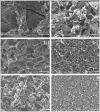Experimental Study of Surface Roughness of Dental Ceramics After Polishing with Three Types of Polishing Systems
- PMID: 36532324
- PMCID: PMC9753920
- DOI: 10.4103/jispcd.JISPCD_107_22
Experimental Study of Surface Roughness of Dental Ceramics After Polishing with Three Types of Polishing Systems
Abstract
Aims and objectives: This study evaluated the surface roughness of three dental ceramics after polishing with three types of extraoral ceramic polishing sets.
Materials and methods: One hundred and twenty specimens were fabricated from feldspathic porcelain, lithium disilicate, and zirconia ceramics. The specimens were randomly allocated into four subgroups (n = 10). Group one was glazed (control) and the other three groups were ground using fine diamond burs and then sequentially polished by two rubber wheels from three polishing sets: feldspathic porcelain, lithium disilicate, and zirconia sets. The surface roughness measurement was performed with a profilometer and the surfaces were analyzed using scanning electron microscopy. Elemental compositions of three polishing sets were examined using x-ray powder diffraction. The surface roughness values of three polishing systems were compared by one-way analysis of variance with Dunnett's T3 post hoc test. The significance level was set at p < 0.05.
Results: There was no significant difference in surface roughness when polishing ceramics with the lithium disilicate and zirconia polishing sets. In addition, those two sets provided lower roughness compared with the feldspathic porcelain polishing set and glazing. The main component of all polishing wheels was carbon, and only zirconia polishing wheel had more additional trace elements, which were titanium and silica.
Conclusion: Lithium disilicate and zirconia extraoral polishing sets achieved superior results compared to feldspathic polishing set and glazing.
Keywords: Dental ceramic; glazing; polishing; surface roughness.
Copyright: © 2022 Journal of International Society of Preventive and Community Dentistry.
Conflict of interest statement
The authors declare that there is no conflicts of interest.
Figures



References
-
- Fahmy NZ, El Guindy J, Zamzam M. Effect of artificial saliva storage on microhardness and fracture toughness of a hydrothermal glass-ceramic. J Prosthodont. 2009;18:324–31. - PubMed
-
- Kalia P, Nair KC, Jaiswal D, Tikmani C, Banerjee D, Bera R. A comparative study on the effect of polishing systems on the color and surface texture of different porcelain systems - feldspathic, pressable, and computer-aided design/computer-aided manufacturing. J Indian Prosthodont Soc. 2021;21:173–9. - PMC - PubMed
-
- Carrabba M, Vichi A, Vultaggio G, Pallari S, Paravina R, Ferrari M. Effect of finishing and polishing on the surface roughness and gloss of feldspathic ceramic for chairside CAD/CAM systems. Oper Dent. 2017;42:175–84. - PubMed
-
- Ismail NH, Awang RA, Kung HS. Surface roughness and colour stability of dental porcelain treated with different polishing methods. Int J Dent Oral Sci. 2020;7:766–9.
-
- Mohammadibassir M, Rezvani MB, Golzari H, Moravej Salehi E, Fahimi MA, Kharazi Fard MJ. Effect of two polishing systems on surface roughness, topography, and flexural strength of a monolithic lithium disilicate ceramic. J Prosthodont. 2019;28:e172–80. - PubMed
LinkOut - more resources
Full Text Sources

